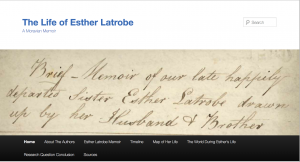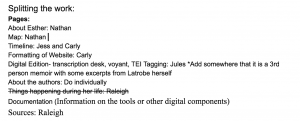After hearing this final assignment our whole group really rose to the challenge and took it as an opportunity to create something that’s never been done before. As Professor Faull states, “the genre of Moravian memoir has not received much attention from North American spiritual autobiography” (Faull, 248). Turning the world one step at a time into a more accessible, digital place was never something I thought I would be involved in. It was a very interesting, unique process that I was honored to be apart of.
Looking at our research question “How did Esther Latrobe’s relationship with God affect her lifestyle, and help her recover from such illnesses and hardships?”, it was hard to give a single answer. There were many aspects of Esther’s connection with God that impacted her in different ways. I truly believe that her dedication to the Lord lead to positivity however there were many branches that we explored through her life. My biggest challenge throughout this final project was viewing this question as an exploration. Coming to a single conclusion wasn’t possible. There were many different ways our group found ways to explore our research question by using distant and close reading tools such as voyant tools, story map js, contextual events, the digital edition, timeline, and TEI tagging. Including all of these in our final website was a challenge however my teammates and I were more than successful in accomplishing this goal.
Starting this project, it seemed like there were so many aspects to include in one project. However, using a WordPress website was a very useful database. Our first challenge we had as a group was figuring out how to work all the resources available in WordPress. Many of us were not technically advanced with this database. Luckily, for my final project in my foundation seminar course we had people from the library come in to teach us how to work WordPress in order to create a personal website. I was able to guide our group in this portion of the project, especially in the beginning when dealing with the formatting. After I created the website our group had to choose a theme. Our group came together and gave each other different options for the group to explore until we found the right one.
Then for formatting, having different tabs along the toolbar made it easy to show how each tool helped us come to different conclusions for the extent Esther was connected with God and how it helped her journey. When our group started this project, the first thing we did was make these tabs. It made it easy for the viewer to not get overwhelmed with the amount of information available and it was easy to access.

We laid out all of the things that we needed to include to accurately represent our exploration. Once we were able to see all of the tasks that needed to be completed, we divided and conquered. We made a group google doc and equally split up the work depending on what we thought we could best contribute to. We also took into consideration that I was editing and helping design the website therefore I didn’t have as much writing to do. This was all discussed in class and therefore written down and everyone followed their assignments. Our group did this very efficiently.

For our website content we included “about the authors” as it gave a background of who the researchers were and why we were doing this. We also included a summary of Esther Latrobe’s memoir so that the viewers could understand who Esther was and what we read in her memoir. Including a picture along with a copy of the actual memoir gave the viewer the ability to empathize with the process we went through of transcribing this memoir. After including all the tabs that had to do with our exploration of our research question I went back and realized how important they were in answering our research question. Writing the conclusion tab gave a purpose to this website and made me reflect on all of the work we had done this semester.
An important tab that was included was the Story Map page. This “provided geographical context and depth to an expert interpretation of the past” (Bodenhamer 28). Placing this on the website demonstrated our conclusions that we drew from Esther’s physical geographical path. Having this map showed how motivated Esther was on her journey, part of me assumes that the Lord was her ultimate driving force for her to travel.

Also knowing when historical events happen in relation to each other “tell us about its visions of past and future” (Grafton 11). Including the timeline that we worked on for a good portion of class was necessary. Giving context with events that happened in places she traveled to gave a better understanding of Esther as a person. The website http://www.gracehillvillage.org/ gave a lot of history on a a special place in Esther’s life, Gracehill.
Including these two important tools as well as others, and including screenshots from them into the page, made it easy for the viewer to follow our research. All of these tabs helped explore the ultimate question of how did Esther Latrobe’s relationship with God affect her lifestyle, and help her recover from such illnesses and hardships? The tools that we were given access to, we took full advantage of in order to explore this question fully. Seeing more and more about her life from different perspectives made it easier to see why she was motivated to do what she did. After transcribing the memoir and realizing how she handled her illness, we immediately realized how big a role having hope in the Lord played as it settled her feelings making it a more positive experience.
Exploring this question with my group was a positive educational experience. We worked together very easily and learned each other’s strengths and weaknesses after working together for a whole semester. We were very successful with our research and advancements to finding out about Esther Latrobe’s life.
http://latrobehumn100.blogs.bucknell.edu/
Carly Pavoni is from Fairfield, CT. She is a freshman at Bucknell University that is undeclared in the arts and sciences school. She is on the track and field team at Bucknell University.



